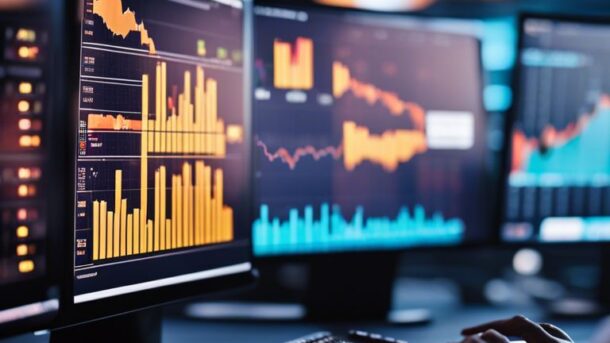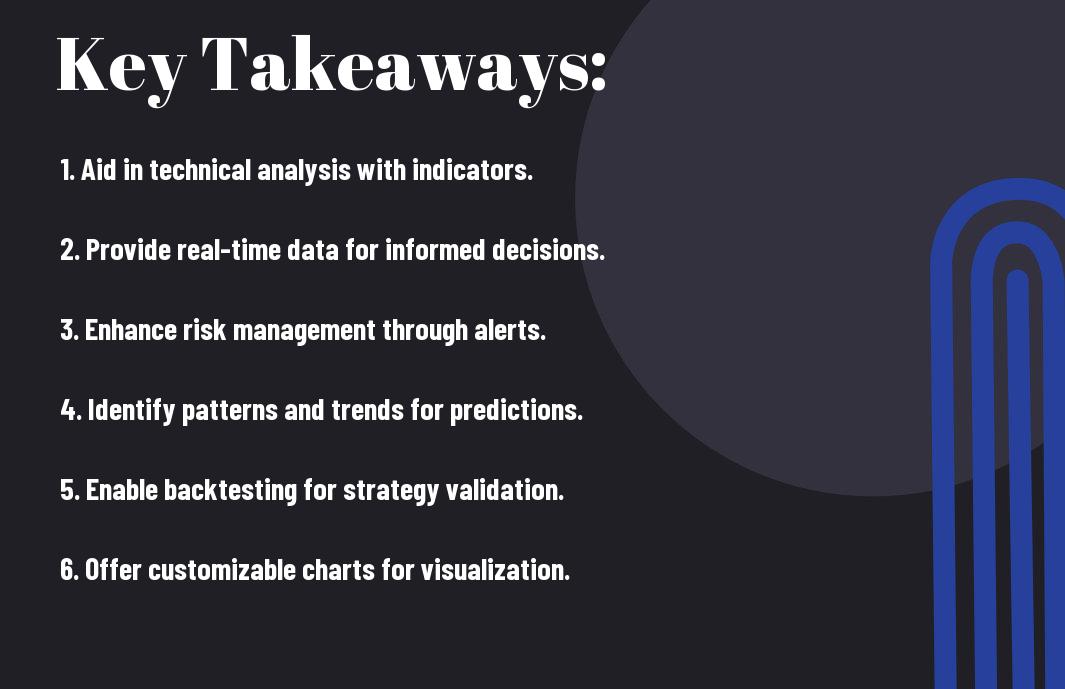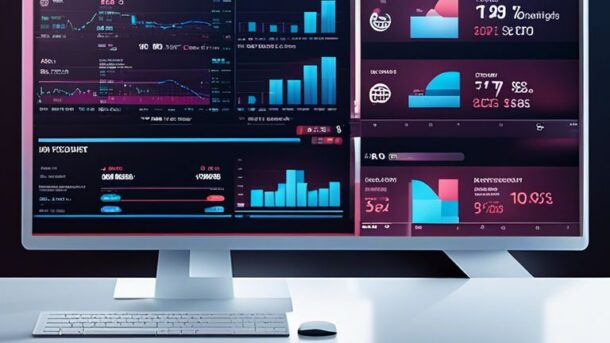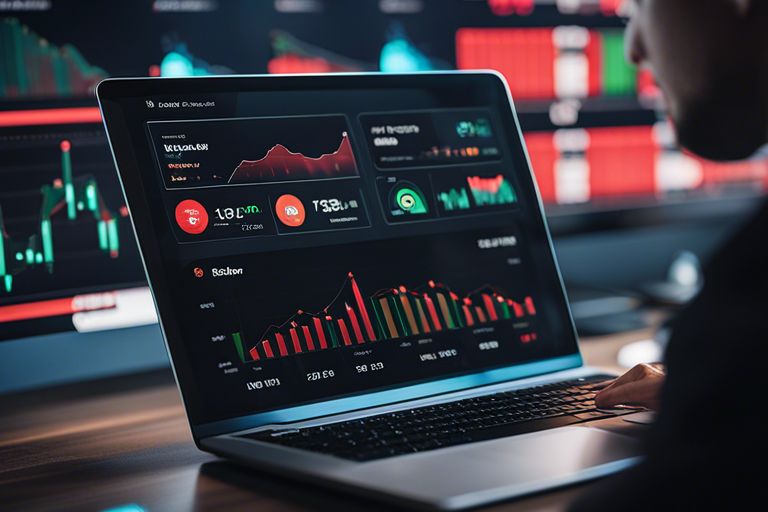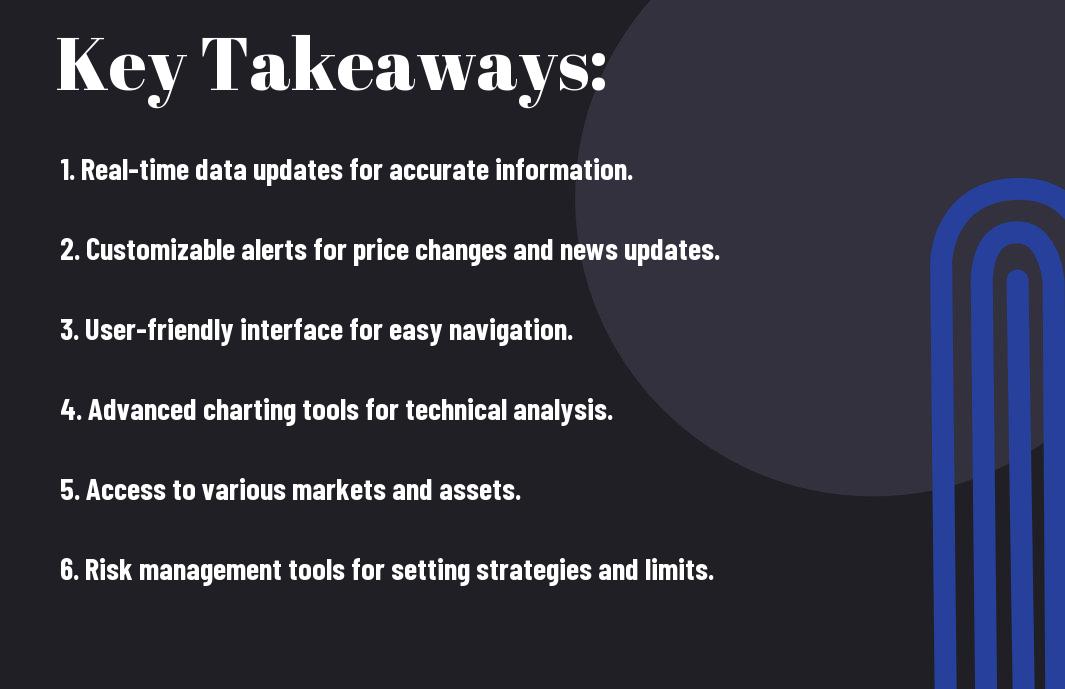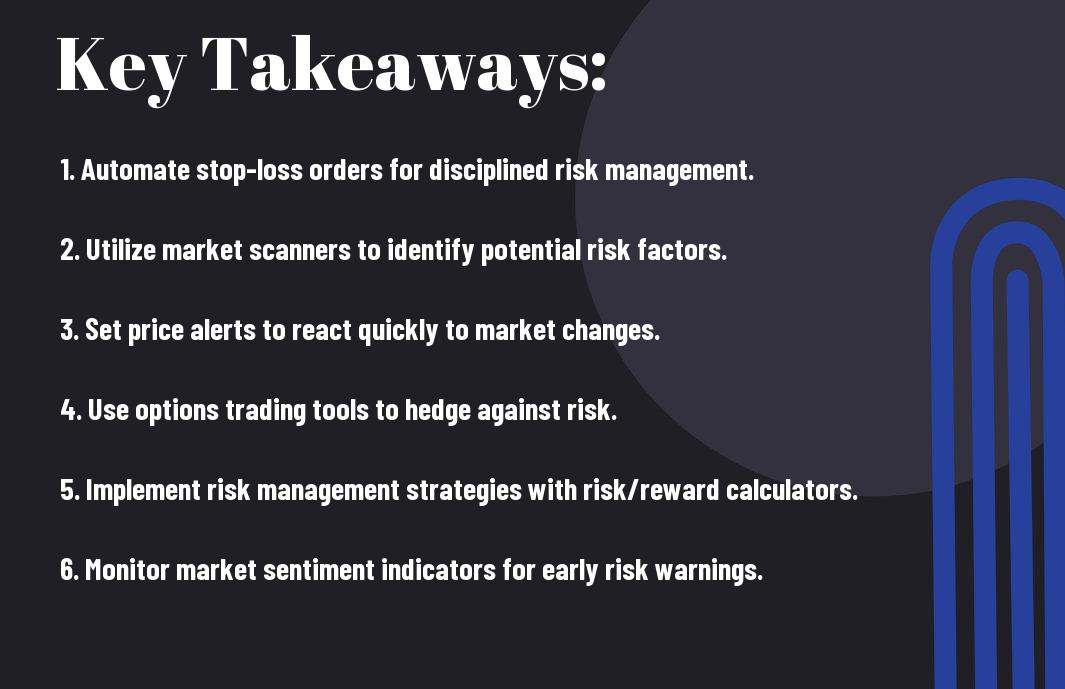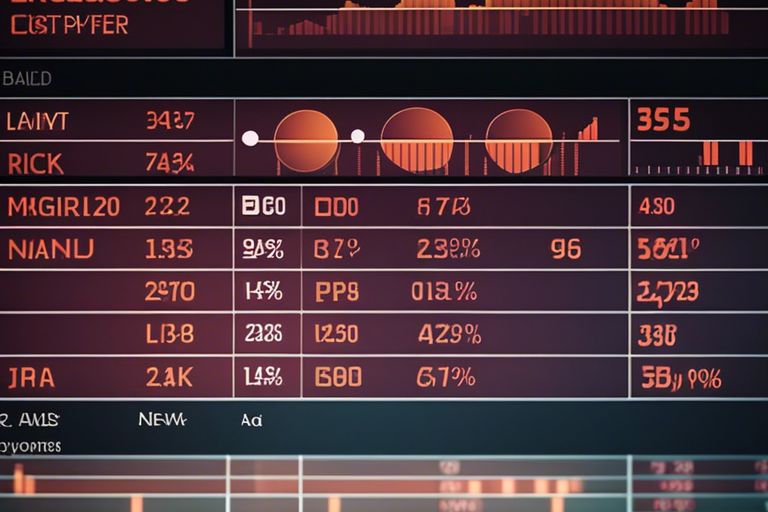Trading in the stock market can be daunting for individual investors like yourself, but fear not, as a plethora of trading tools exist to simplify the process. From charting platforms like TradingView to algorithmic trading tools such as MetaTrader, there are options for traders of all experience levels. Your trading journey can be enhanced with these popular tools designed to help you analyze market trends, execute trades efficiently, and ultimately increase your chances of success in the complex world of trading.
Key Takeaways:
- Charting Software: Charting tools like TradingView and MetaTrader are popular among individual traders for analyzing price movements and identifying trading opportunities.
- Screeners and Scanners: Tools such as Finviz and StockFetcher help traders filter stocks based on certain criteria like volume, price, and technical indicators.
- Algorithmic Trading Platforms: Platforms like Thinkorswim and NinjaTrader offer features for automated trading and backtesting trading strategies, appealing to traders looking for more advanced tools.
Types of Market Trading Tools
While trading in the markets, it’s important to have the right tools at your disposal to make informed decisions. There are various types of market trading tools available for individual traders to utilize. These tools can help you analyze market trends, track stock movements, and make well-informed trading decisions.
- Technical Analysis Tools
- Fundamental Analysis Tools
- Trading Platforms
- Financial News Sources
- Charting Software
After familiarizing yourself with the different types of market trading tools, you can choose the ones that best suit your trading style and preferences.
Technical Analysis Tools
One of the crucial types of market trading tools is technical analysis tools. These tools help you analyze historical price data, identify patterns, and make predictions about future price movements. Common technical analysis tools include moving averages, MACD (Moving Average Convergence Divergence), RSI (Relative Strength Index), and Fibonacci retracement levels.
| Technical Analysis Tools | Function |
| Moving Averages | Smooth out price data to identify trends |
| MACD | Indicates the relationship between two moving averages |
| RSI | Measures the momentum of price movements |
| Fibonacci Retracement Levels | Identifies potential support and resistance levels |
Fundamental Analysis Tools
The other crucial type of market trading tools is fundamental analysis tools. These tools help you evaluate a company’s financial health, growth potential, and overall value. Fundamental analysis tools include financial statements, earnings reports, economic indicators, and industry trends. By analyzing these factors, you can make more informed investment decisions based on the underlying strength of a company.
A fundamental analysis tool like financial statements can provide you with valuable information about a company’s profitability, revenue, and expenses. By examining these financial metrics, you can assess the financial stability and performance of a company, helping you make better investment choices.
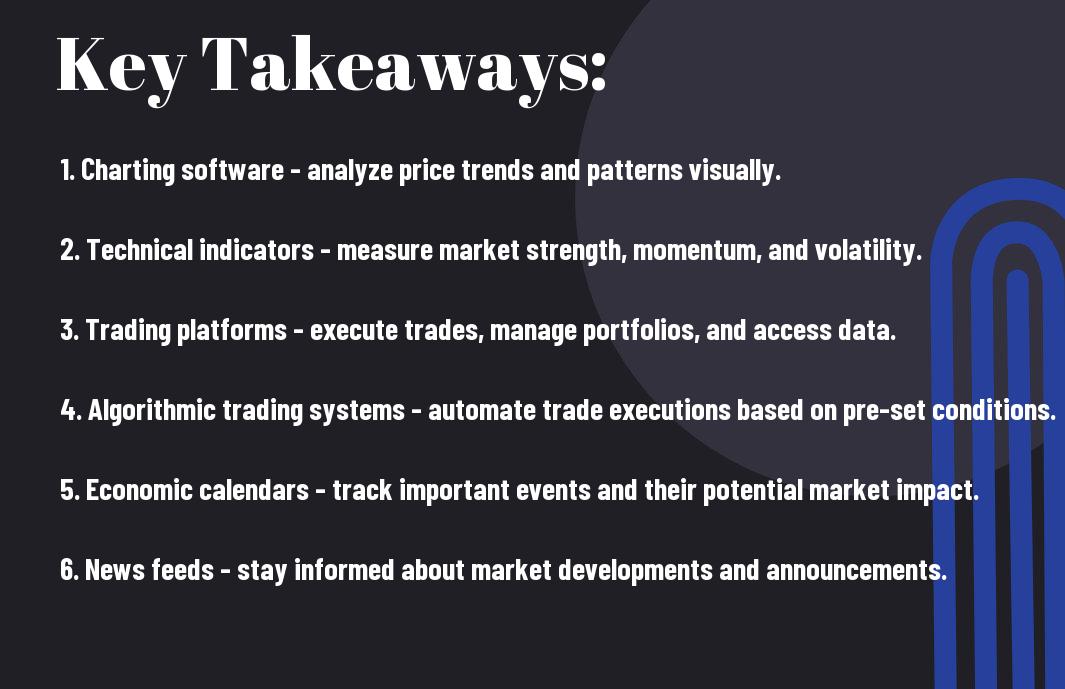

Charting and Visualization Tools
Even in today’s digital age, charting and visualization tools remain necessary for individual traders looking to analyze market trends and make informed trading decisions. These tools help you visualize historical price data and identify patterns that can assist you in predicting future market movements.
Candlestick Charts
With candlestick charts, you can easily track the open, high, low, and closing prices of a security over a specific time period. Each candlestick provides you with valuable information about the market sentiment and can help you determine potential entry and exit points for your trades.
Line Charts
With line charts, you can see the general price movements of a security over time. These charts connect the closing prices of each period with a line, offering a clear and straightforward visualization of trends. While line charts may not provide as much detail as candlestick or bar charts, they are great for gaining a quick overview of how a stock is performing.
The simplicity of line charts makes them ideal for beginner traders who are just starting to analyze market data. They can help you develop a basic understanding of how prices are moving and provide a solid foundation for more advanced charting techniques.
Bar Charts
Charts with bar formations display the open, high, low, and close prices of a security for a specific period. Each bar represents this price information, making it easy for you to assess price movements and volatility. Bar charts can be particularly useful in identifying potential trend reversals and market turning points.
Another benefit of bar charts is their ability to show price action more clearly than line charts. By analyzing the length and position of the bars, you can gain insights into market strength and potential price direction. This information can be valuable when making trading decisions in volatile market conditions.
Market Data and News Feeds
Despite the myriad of trading tools available to individual traders, having access to up-to-date market data and news feeds is crucial for making informed decisions in the fast-paced world of trading. You can access real-time market data and news feeds through various online brokers. Forbes provides a list of the 6 Best Online Brokers For Day Trading Of June 2024 that offer top-notch market data and news services.
Real-time Market Data
To stay on top of market trends, real-time market data is important. It allows you to track price movements, volume fluctuations, and other key indicators that can influence your trading decisions. With access to real-time market data, you can react quickly to market changes and seize profitable opportunities.
News Aggregators
News aggregators compile news articles and updates from various sources into one platform, allowing you to stay informed about market-moving events and developments. By utilizing news aggregators, you can access a wealth of information and analysis that can help you anticipate market movements and make informed trading decisions based on current events.
Data from news feeds can provide valuable insights into how news events impact different asset classes and industries. By staying informed about the latest news through news aggregators, you can gain a competitive edge in the markets and adjust your trading strategies accordingly.
Economic Calendars
Market volatility often spikes around economic releases, making economic calendars a valuable tool for traders. Economic calendars list upcoming economic indicators and events, such as employment reports and GDP releases, along with their expected impact on the markets. By consulting an economic calendar, you can plan your trading around major economic events and manage risk more effectively.
The ability to anticipate market reactions to economic data can help you make more informed trading decisions and avoid unexpected volatility. By incorporating economic calendars into your trading routine, you can stay ahead of market developments and adjust your strategy based on upcoming events.
Automated Trading Tools
Algorithmic Trading Platforms
Not all traders have the time or expertise to constantly monitor the markets and execute trades. This is where algorithmic trading platforms come in handy. These tools use pre-set parameters to automatically place trades on your behalf based on market conditions, trading signals, and strategies.
One popular algorithmic trading platform is MetaTrader, which allows you to create customized trading algorithms using MQL programming language. These platforms can help you execute trades faster and more efficiently, taking emotion out of the equation.
Expert Advisors
Any trader looking to automate their trading strategies should consider using Expert Advisors (EAs). EAs are programs that run on trading platforms like MetaTrader and can analyze the markets, generate signals, and execute trades automatically based on your set criteria.
A well-designed EA can help you take advantage of trading opportunities 24/7, without the need for constant monitoring. You can also backtest EAs using historical data to see how they would have performed in the past.
Trading Bots
Algorithmic trading bots are automated software programs that interact directly with exchanges to place trades on your behalf. These bots can be programmed to execute trades based on specific parameters, such as price movements, volume, and technical indicators.
Trading bots can be especially useful for executing high-frequency trades or for trading in multiple markets simultaneously. However, it’s vital to choose a reputable bot and keep a close eye on its performance to ensure it aligns with your trading objectives.

Risk Management and Analysis Tools
Many market trading tools cater to individual traders by providing risk management and analysis features. These tools help you make informed decisions and manage your trading risks effectively.
Position Sizing Calculators
With position sizing calculators, you can determine the ideal position size for your trades based on your risk tolerance and trading strategy. By inputting variables such as your account size, risk percentage per trade, and stop-loss level, these calculators help you avoid overleveraging and potential losses.
Risk-Reward Ratio Analyzers
To enhance your risk management strategy, utilizing risk-reward ratio analyzers is necessary. These tools allow you to assess the potential risk and reward of each trade before entering the market. By calculating the ratio between your potential profit and potential loss, you can make data-driven decisions and improve the overall risk-reward balance in your trading.
Another valuable tool in your trading arsenal is portfolio optimization tools. These tools help you diversify your investments effectively, reducing overall risk and maximizing returns. By analyzing correlation, volatility, and historical performance data, portfolio optimization tools aid in creating a well-balanced and resilient investment portfolio.
Portfolio Optimization Tools
For successful trading and long-term investment growth, utilizing portfolio optimization tools is crucial. These tools help you identify the optimal asset allocation based on your risk preferences and return objectives. By considering various factors such as asset correlation and historical returns, you can construct a diversified portfolio that aligns with your financial goals.
Trading Platforms and Brokers
Once again, when it comes to market trading, having access to the right tools is crucial for your success. Trading platforms and brokers play a significant role in enabling individual traders to execute trades efficiently and effectively. These tools provide you with the necessary interface to access the financial markets and make informed decisions about your investments.
Online Trading Platforms
Any serious trader knows the importance of a reliable online trading platform. These platforms offer a wide range of features such as real-time market data, advanced charting tools, and order execution capabilities. They allow you to trade various financial instruments, monitor your portfolio, and analyze market trends from the comfort of your own home.
Mobile Trading Apps
Trading on the go has never been easier with the availability of mobile trading apps. These apps allow you to access your trading account from your smartphone or tablet, enabling you to monitor your positions, place trades, and stay updated on market news no matter where you are. They provide you with flexibility and convenience, ensuring that you never miss out on trading opportunities.
Online trading platforms have revolutionized the way individual traders participate in the financial markets. With just a few clicks, you can access a world of trading possibilities and take control of your investments like never before.
Brokerage Firms
Brokerage firms serve as the intermediary between you and the financial markets, facilitating your trades and providing you with access to various investment products. They offer a range of services, including trade execution, research and analysis tools, and customer support to assist you in your trading endeavors. Choosing the right brokerage firm is vital to ensure a seamless trading experience and maximize your potential returns.
For instance, some brokerage firms specialize in certain markets or investment products, so it’s important to select one that aligns with your trading preferences and goals. By partnering with a reputable brokerage firm, you can benefit from their expertise and resources to enhance your trading performance and achieve your financial objectives.
Summing up
Presently, you have learned about some of the most popular market trading tools available for individual traders. By utilizing tools such as technical analysis software, economic calendars, news sources, and social trading platforms, you can enhance your decision-making process and potentially increase your chances of success in the market. Remember to research and test each tool to find the best fit for your trading style and goals.
FAQ
Q: What are the most popular market trading tools available for individual traders?
A: The most popular market trading tools for individual traders include:
- 1. Stock Screeners: Tools that help traders filter and find stocks based on specific criteria such as price, market capitalization, volume, etc.
- 2. Technical Analysis Tools: Software that provides charts, indicators, and drawing tools to help traders analyze price movements and make informed decisions.
- 3. Trading Platforms: Online platforms that allow traders to buy and sell financial instruments, access real-time data, and manage their portfolios.
- 4. News and Research Tools: Services that provide market news, analysis, and research reports to help traders stay informed about the latest developments.
Q: How can stock screeners help individual traders in their trading activities?
A: Stock screeners are vital market trading tools for individual traders as they enable traders to:
- 1. Identify Opportunities: Screeners help traders find stocks that meet specific criteria or parameters set by the trader, allowing them to discover potential trading opportunities.
- 2. Save Time: Instead of manually searching for stocks, screeners automate the process, saving traders time and effort.
- 3. Make Informed Decisions: By using screeners to filter stocks based on fundamental or technical factors, traders can make more informed trading decisions.
Q: What features should individual traders look for in a trading platform?
A: When dicking out a trading platform, individual traders should consider the following features:
- 1. User-Friendly Interface: A platform that is easy to navigate and use, especially for beginners.
- 2. Real-time Data: Access to up-to-date market data, news, and charts for informed decision-making.
- 3. Order Types: The ability to place different types of orders such as market orders, limit orders, and stop orders.
- 4. Portfolio Management Tools: Features that help traders track and manage their investments and performance.
- 5. Customer Support: Responsive customer service and technical support to address any issues or questions.
